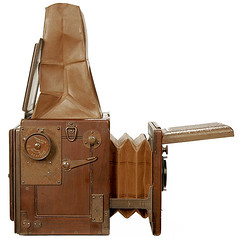Difference between revisions of "Ensign Reflex"
(two additional detail shots of diff. model added to our pool) |
(A bit more text, and a link to an example at Westlicht.) |
||
| Line 11: | Line 11: | ||
|image= http://farm4.static.flickr.com/3345/4638486931_7e891456c5.jpg | |image= http://farm4.static.flickr.com/3345/4638486931_7e891456c5.jpg | ||
|image_align= right | |image_align= right | ||
| − | |image_text= Ensign Reflex | + | |image_text= Ensign Special Reflex, closed |
|image_by= Dustin McAmera | |image_by= Dustin McAmera | ||
|image_rights= with permission | |image_rights= with permission | ||
| Line 18: | Line 18: | ||
| − | The Ensign Reflex, Ensign Deluxe Reflex, Ensign Popular Reflex and Ensign Special Reflex were a series of large [[SLR]] cameras built in England by [[Houghton and Ensign|Houghton]] from about 1908 into the 1930s. | + | The Ensign Reflex, Ensign Deluxe Reflex, Ensign Popular Reflex and Ensign Special Reflex were a series of large wooden-bodied [[SLR]] cameras built in England by [[Houghton and Ensign|Houghton]] from about 1908 into the 1930s. They are very similar to the [[Soho Reflex]] range made by [[Marion]]. The cameras have a focal-plane shutter (typically with speeds from about 1/10 to 1/1000 second, plus 'T'; the range of speeds varies with the plate size). They are designed to be used at a high waist-level (with the face applied to the top of the folding leather focusing hood to view the ground-glass screen at the top of the body), but can also be used as a view camera, with a second ground-glass screen fitted to the back. |
| + | The lens is mounted in a wooden panel on the front of the bellows, which allows front rise. Focusing is by rack-and-pinion extension of the bellows (the rail on each side of the bellows has teeth on the bottom edge, which mesh with toothed wheels connected directly to the focusing knob on the left side). Some cameras (for example the tropical camera shown here) have focus distances engraved on the rails. The camera body is quite deep (front to back) to accommodate the mirror mechanism, so that a normal lens must be in a slightly sunken mount, almost flush with the lens board. There is a hinged metal cover over the lens, which when raised acts as a shade. | ||
| + | |||
| + | The cameras were made in a variety of plate sizes. Tropical versions were made of some models. | ||
| Line 57: | Line 60: | ||
|image_rights= with permission | |image_rights= with permission | ||
}} | }} | ||
| + | |||
| + | ==Links== | ||
| + | * [https://www.westlicht-auction.com/index.php?f=popup&id=260660&_ssl=off#260660 6x9 cm Ensign Special Reflex, tropical] with 12 cm f/4.5 CZJ Tessar, sold at the [https://www.westlicht-auction.com/index.php?id=246559&acat=246559&lang=3 May 2012 Westlicht Photographica Auction]. | ||
| + | |||
[[Category:UK]] [[Category:Ensign]] [[Category:SLR]] | [[Category:UK]] [[Category:Ensign]] [[Category:SLR]] | ||
Revision as of 10:13, 15 June 2012

|
| Ensign Special Reflex, c1930s image by Dustin McAmera (Image rights) |

|
| Ensign Special Reflex, closed image by Dustin McAmera (Image rights) |
The Ensign Reflex, Ensign Deluxe Reflex, Ensign Popular Reflex and Ensign Special Reflex were a series of large wooden-bodied SLR cameras built in England by Houghton from about 1908 into the 1930s. They are very similar to the Soho Reflex range made by Marion. The cameras have a focal-plane shutter (typically with speeds from about 1/10 to 1/1000 second, plus 'T'; the range of speeds varies with the plate size). They are designed to be used at a high waist-level (with the face applied to the top of the folding leather focusing hood to view the ground-glass screen at the top of the body), but can also be used as a view camera, with a second ground-glass screen fitted to the back.
The lens is mounted in a wooden panel on the front of the bellows, which allows front rise. Focusing is by rack-and-pinion extension of the bellows (the rail on each side of the bellows has teeth on the bottom edge, which mesh with toothed wheels connected directly to the focusing knob on the left side). Some cameras (for example the tropical camera shown here) have focus distances engraved on the rails. The camera body is quite deep (front to back) to accommodate the mirror mechanism, so that a normal lens must be in a slightly sunken mount, almost flush with the lens board. There is a hinged metal cover over the lens, which when raised acts as a shade.
The cameras were made in a variety of plate sizes. Tropical versions were made of some models.

|
| Ensign Special Reflex, tropical version image by Rick Soloway (Image rights) |

|
| Nameplate Detail image by Dustin McAmera (Image rights) |

|
| Detail of Ensign Reflex nameplate image by nigel_gnp (Image rights) |

|
| Focal-plane shutter settings image by nigel_gnp (Image rights) |
Links
- 6x9 cm Ensign Special Reflex, tropical with 12 cm f/4.5 CZJ Tessar, sold at the May 2012 Westlicht Photographica Auction.